Today we arranged to do two sightseeing tours with Arielle. The morning excursion was up Indian River, the second was a trip to the Syndicate Trails rain forest hike. Andrew picked us up at our respective boats and took us to the dock at the mouth of Indian River. Dominica boasts 365 rivers, but Indian River is one of the few that are navigable. He directed us to the gas station/mini market to buy tickets into the wildlife preserves. Both Syndicate and Indian Rivers are in preserves, and we asked for a day pass for both parks. The clerk sold us the tickets, and assured us it was a day pass good for both parks, and sent us back to the boat. We picked a great day for sightseeing. It was clear, sunny and warm out. Actually, it was a little on the hot side.
Beyond the dock, it is forbidden to use a motorboat on Indian River, so Andrew pulled out his paddles and started rowing us up stream. Why, you ask, did we not simply take our own handy dandy rowing dinghy up there? The reason is because, like Barbuda, individuals are not allowed in the protected waters without a licensed guide.
The water is shallow, which makes rowing even harder because you can’t dig oars in enough to make powerful strokes. He must be in good shape. The river is lazy, with many twists and turns as it meanders its way down to the bay. Near the mouth of the river, it is mostly low growing plants on both sides of the river, but the farther up we went, the taller and denser it became, until we were in a thriving forest. Upstream, the trees are mostly tall and thin, with a canopy that blocks the majority of the sun and sky above the river. It is serene and peaceful in the river, the only sounds being from mother nature and the oars paddling in the water.
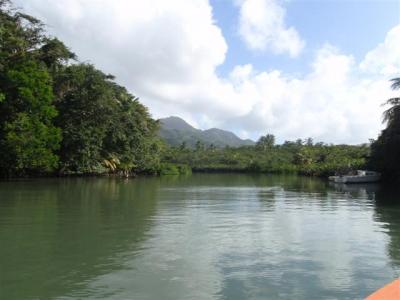
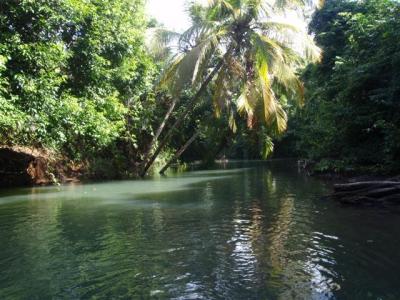
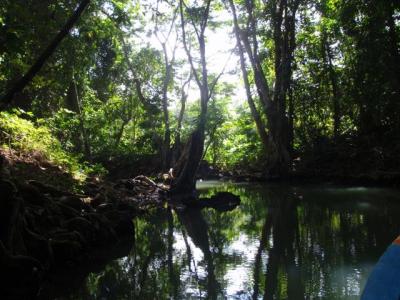
Andrew pointed out the various species that live along the river, including the assorted plants, the fish, crabs, birds, etc, and told us a little bit about them all. Near the river mouth he pointed out a species of fish that prefers brackish water. Farther up the river there lives a freshwater species. It sounds like only these two fish species live in the water, but there seem to be lots of them and they are pretty good size fish. He pointed out a bug species that seems to live on the surface of the water.
We noticed there is a lot of elephant ear plant, which we saw a lot of in the South Pacific, too. One of the things we found incredibly interesting is that one of the more common vines grows from the top down. Birds eat the seeds, then poop them in the tree tops. The plant actually takes root in the tree top, and as it grows, grows downward, wrapping itself around the tree. Most plants grow upward, so that is an interesting variation on nature. He showed us termite nests mounted up in the trees. Termites are an important facet of the jungle ecosystem. Their nests are in living trees, but they only eat dead wood, thus naturally clearing out the dead stuff and renewing the cycle of life. And in jungles, there is a lot of dead wood that needs to be gotten rid of. Of course, when it comes to houses, termites are a problem, not only because they eat the wooden planks, but also because they will eat stuff like wiring that happens to be mounted along the wood. We have noticed that most of the houses we have seen under construction in the tropics look to be made of concrete. No wonder why.
Andrew also pointed out several birds. We can’t remember the name of it, but he pointed out a black bird with a red stripe running down its head, which we have never seen before. He pointed out a few hummingbirds and egrets. The information about hummingbirds is fascinating. These itty bitty birds go to other islands and back. You wouldn’t think that they would be strong enough for such rigorous flights, but they are. They are one of few birds that can hover in place, like a helicopter, and they are always in motion. And, they will eat sand to make themselves heavier so they don’t blow away.
There were lots of crabs running around. There are several species that live here, and the ones we saw were mostly big and light colored. He also spotted some iguanas high in the trees. He has good eyes to see them. He explained the females are bright green, and the males are a more brownish shade.
At one point, he pointed out some concrete pillars and explained that the British had once built a road (or railroad?) that crossed the river here. It was a wooden bridge that was damaged in a hurricane. They never tried to repair it, and it was quickly reclaimed by the jungle. Even the concrete posts are visibly being swallowed up by the jungle.
At another bend of the river, he pointed out where they had filmed a scene from Pirates of the Caribbean II, which is the spot the third picture above was snapped at. It is the scene where Captain Jack Sparrow visited the old witch in the bayou. They built a house at the bend and brought in a smoke machine to make it feel eerie. Andrew had been involved in the filming and pointed out the assorted camera angles.
The end of the ride is the Indian River Bush Bar, ¾ of a mile upstream. We all unloaded at a tiny dock and walked under the roof of the open air bar. We were greeted by the owner, Cobra, who is quite the character.

He gave us a tour of the grounds. Next to the bar is a two story hut. The downstairs is kind of a mini museum, showing the old style pillows and blankets they used to use in the old days. The upper area is a guest house. He has put a lot of energy into creating an extensive garden, and all the plants are indigenous to the island. It is nicely landscaped, and features some gorgeous tropical flowers. His pride and joy is his red banana tree, which are extremely rare. The tree is much taller than any banana tree we have ever seen before. It only yields half the number of stalks as yellow banana trees produce. He says the bananas are especially delicious, but since none were ripe, we didn’t get to taste for ourselves. Michael and Jack from Arielle are walking on the garden path.
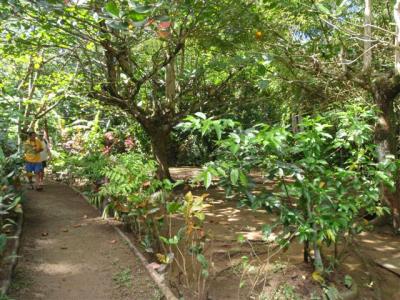
After our little tour, Cobra grabbed a stalk of sugar cane and a coconut. He cut pieces of the cane for us and insisted we try some. It tastes like sugar, just not as concentrated as we are used to with the refined stuff. The stalk is fibrous and you chew on it to get all the juice out of it, then spit out the fibers once sweetness is all gone. Then he cut up the coconut for us to try. The first pieces were just the white, meaty flesh. He explained that the brown inner skin of the coconut is where all the oil is concentrated. He cut another piece for us with the skin on (to clarify: not the inedible husk, the skin between the husk and white flesh). We didn’t notice any difference in taste with the skin or without it. Then had us suck on cane stalks while we had coconut pieces in our mouths. Obviously, the sweetened coconut was even better. The second shot is of the crabs he caught along the shore for lunch.
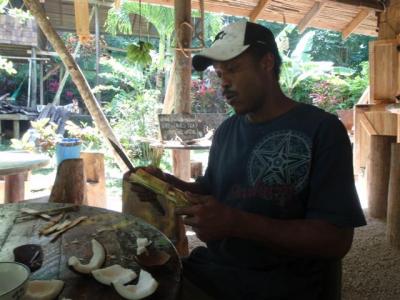
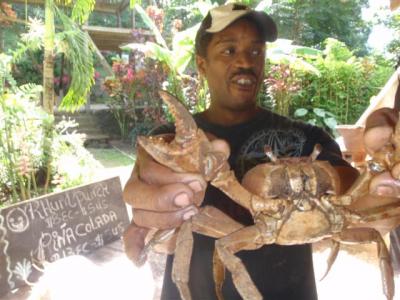
His bar sells the self-proclaimed best rum punch on the island. Being as it was still morning, we opted for pure, fresh squeezed passion fruit juice instead of rum punch. The juice is phenomenally good. We sat in the bar and watched the wildlife for quite a while. We saw a couple humming birds. In our Mammal Park story we had posted pictures of two different birds eating. We saw both of those little birds here, too. There was a little yellow bird that we saw often on Antigua, but have no idea what it is called. And there are a few varieties of lizards. One species that caught our eye is bright yellow.
When it was time to head out, Andrew paddled us back down the river and dropped us all off at Arielle. We were gone a little over two hours door to door. Arielle’s crew served us a quick lunch before heading off to our afternoon tour. We were picked up by a gentleman named Winston, who was in a nice mini-van. We found out the girl who sold us our tickets had given us incorrect information. The passes were good for only one park, not for multiple parks in the same day. We had to make a stop to buy more park passes before we set off. The same girl was there, and when we explained that she had misinformed us, she seemed to not register the concept that was a difference between single use passes and multi-use passes.
Once we had passes in hand, Winston took the road along the water to the outskirts of town, near the customs place. He turned onto another main road that headed up a steep mountain. After a few blocks, there was a distinct change in the people walking around. Dominica’s inhabitants are almost all black, and we had seen lots of black people walking around as we drove. Suddenly, there were a lot more people in the streets, representing every ethnicity imaginable, most of them in their early 20’s and many of them sporting back packs. There were also a few people exercising and many people milling around food stalls. Winston explained that we were approaching the campus of Ross Medical School, of which almost all the students are Americans. A block later we drove by the campus. It is very nice and quite large. Winston told us it has been around for 20 years and has been steadily growing in size. There are tons and tons of small apartment complexes near the campus to accommodate the students. The school and surroundings are by far the most developed and most upscale part of the island we have seen so far, and the area really does have a university feel to it.
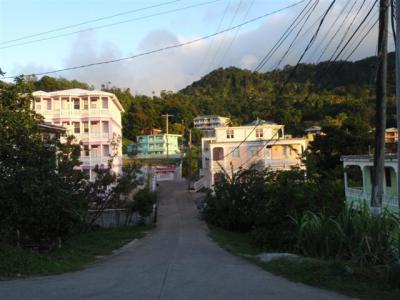
Beyond the school is mostly undeveloped land. As we climbed up higher, the landscape became noticeably greener and more lush. It is absolutely beautiful and offers the occasional glimpse of the ocean below. We followed a steep and winding road for a while before turning off onto a smaller road. Beyond turn off, it became mostly farmland on both sides of the road. They seem to grow a variety of different things. We definitely identified bananas, grapefruit, oranges, and taro. The road was super steep, windy, and only wide enough for one car. The drivers all honk as they round corners to warn any oncoming traffic of their presence. When we would meet an oncoming car, the downhill vehicle would have to back up to a shoulder and allow the other to pass. And backing around a bend on a little cliff ledge in a big minivan is a little scary, especially when it is a long way to the nearest shoulder.
To be continued”¦
